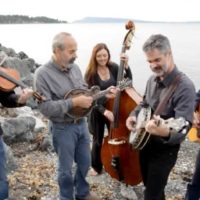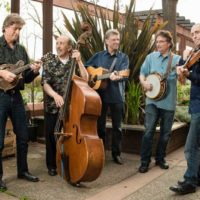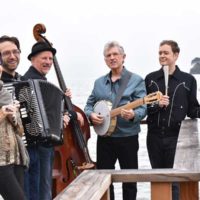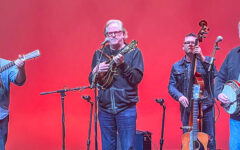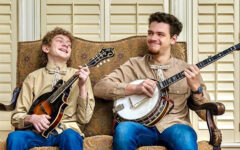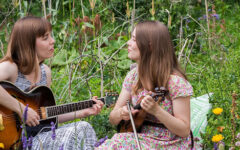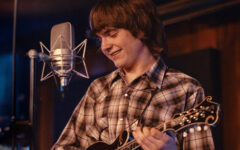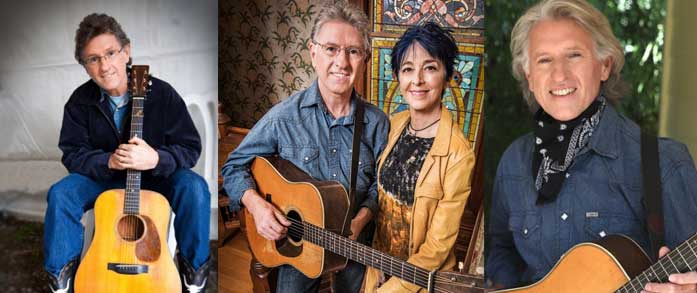
Jim Nunally is a California-based musician’s musician, not so widely known despite having played extensively with many great California artists, including both the David Grisman Bluegrass Experience and John Reischman and the Jaybirds. He’s a sought-after producer, and nowadays spends most of his off time in the Nell & Jim Band, featuring duets with his musical mate, Nell Robinson. He’s also started his own line of Banjo Boy Coffee. There’s so much more to this talented picker, so read on below.
Thanks for your time, Jim. Tell us about your first guitar and how you were able to progress on it at a young age.
The guitar I first learned on was a Kay resonator-style guitar—I remember the action being very hard. It was one of a few guitars my dad had gotten in a trade for some mechanic work on someone’s car. It wasn’t my own guitar, it was my dad’s. The first guitar that was my own was a Hofner acoustic dreadnought shape, which my folks gave me for my birthday, I think I was 14. The first Martin guitar I owned, and still own, was given to me for Christmas in 1976. My brothers and parents all went in on that. It was one of the most wonderful gifts I’ve ever received.
Do you remember the first songs that you learned?
When I first started guitar I was eight years old. My dad taught me Old Paint with just D and A chord—a great song and simple to play.
Do you play anything other than the guitar?
I’ve dabbled in the mandolin, fiddle, banjo, and dobro. Did a little bit of learning on each of those, but have always stuck with the guitar as my primary instrument.
What influences were important in your early years?
My father, Darrell Nunally, was my biggest influence. He taught me the guitar, which he learned from his dad. Early influences would have to be Pat Dorn, Bob Smith, and John Blasquez, who are all local folks who showed me a lot of music, and turned me on to great music on records. It was their guiding me to listen to other music and their friendship that really inspired me.
Who are your favorite rhythm guitarists?
I got my sense of time from my dad. Tony Rice would be my all-time favorite rhythm guitarist, not only because of what he played but also because his tone was absolutely beautiful. As for swing jazz-type stuff, I really love David Johns’s playing. I met him at Weiser, Idaho, at the National Fiddle Championships around 1984. I learned a ton watching him play. Vern Baumann and Rich Levine were inspiring to me too.
When did you first hear a banjo and how did it impact you?
I probably heard it on Hee Haw or some other television show. My early music influence, Bob Smith, is a great banjo player, and was also patient in teaching me bluegrass music. I played with some other excellent players too, like Greg Clark and Phil Allen.
What differences do you see in the music you were exposed to in Arkansas versus California?
I’m actually from California. My dad was from Arkansas, and his dad moved the family to California during the Dust Bowl. The interesting thing about my dad’s timing was that it had a feel like Carl Perkins or Elvis. There’s a groove in that music that comes from the region those folks are from, cotton field country.
You played on the Grammy Award-winning True Life Blues: The Songs Of Bill Monroe. Can you talk about that?
It was a thrill and totally unexpected. I played guitar on a Kathy Kallick recording. At the time, that track was to be put on one of her solo CDs. Todd Phillips, who was producing the record for Kathy, was working on another project at the same time, and the track ended up being put on the True Life Blues CD by Sugar Hill Records.
Most guitarists would be thrilled to play with either Dawg or John Reischman, and you’ve played extensively with both. How did this affect your playing?
Well, those are two of the greats of the mandolin. I spent probably 16 years with Dawg and 17 years with John. Imagine playing hundreds of gigs standing next to those guys—it’s hard to explain how important that is. They’re both super supportive musicians, and were really great to me. You can’t buy that kind of education; it’s even crazier that you get to make a living while working with them.
I feel like there’s a power in both of their styles and technique. You learn to embellish that, or should I say, your playing adapts to their groove. I suppose that’s one thing that makes me a good rhythm guitarist—I strive to be supportive of the soloist. I was also able to work a lot on my melodic style of playing in John and David’s bands. They were very melodic, at least that’s the role I chose for myself with them. I did a lot of improv, yet they were doing material that lent itself to melodic playing.
How was your approach different when playing with each of them, and what did you learn?
I wouldn’t say my approach was different. They chose me to play with them because I was a good fit for what they were wanting in a guitarist. So I didn’t have to approach it in any particular way other than the way I was already playing. The music was traditionally based and I was already pretty steeped in that style, so it was simply a good fit.
You’ve done some interesting projects in film and TV. Care to elaborate?
The Snoopy cartoon, called Snoopy’s Family Reunion, was a fun one. It’s airing on the Disney network now. Snoopy and his siblings are born on the Daisy Hill puppy farm. As puppies, they form a bluegrass band. Mike Marshall, another incredible mandolin player, as you know, hired the band for the music. Snoopy plays bluegrass guitar, that’d be me. The band was Rob Ickes on dobro, Tony Furtado on banjo, and Kaila Flexer and Mike Marshall on fiddle. Todd Phillips, who plays bass, becomes a jug player somehow on the TV show. It originally aired on CBS.
Ha! So Dan Tyminski had George Clooney and you had Snoopy, who’s arguably more famous.
For another project, Béla Fleck hired the band to recut the theme song for the Beverly Hillbillies movie. Béla plays banjo of course, Mike Marshall plays mandolin, Sam Bush plays fiddle, Jerry Scheff plays bass, and Jerry Scoggins, the original singer on the television recording, sings. One interesting story Mr. Scoggins told me was that he ended up singing the song with Flatt & Scruggs instead of Lester Flatt because Lester sounded too much like a hillbilly! I also played on the SimCity soundtracks, which sold more than 40 million copies.
What influences or other artists do you listen to?
I listened to so much music at a very early age. I love Don Rich and Buck Owens, Chet Atkins, Jerry Reed, Jimi Hendrix, Stevie Ray Vaughn, Jim Hurst, Eddie Pennington, Glen Campbell, Vince Gill—there are so many great players, too many to list. The current crop of players are really incredible, like Billy Strings and Molly Tuttle.
Is there a secret to making duets sound great?
It’s no secret that practice makes perfect, or at least gets you going somewhere, which may not necessarily be perfect or great. A key point to singing a nice duet is singing with someone who has an idea of the same sound you’re going for. My first deep dive into that experience was with Dix Bruce. We have very different vocal and guitar sounds, yet our blend was nice because we knew what we wanted our material to sound like. I approach it like that. In my duo with Nell Robinson, we have a natural Southern quality in our voices. My Southern sound comes from my father’s Arkansas dialect, and Nell’s from her Alabama roots. We’ve practiced a lot and that makes a big difference.
In my duo with Keith Little, and working with him in the David Grisman Bluegrass Experience, it was a golden opportunity to sing with an incredible harmony singer. That stuff can rub off on you in a great way. Learning to try to fit your voice in with another person is a fun skill. I also did some great-sounding duets with Trisha Gagnon in the Jaybirds. Trisha has a really rich resonant voice, unlike my sound, yet we made some nice-sounding recordings.
Can you share some of your practice routines?
I usually practice when I’m getting ready for a music event, be it a gig or a recording session. I don’t have a regular routine. I simply try to learn the material as best I can and practice it ’till it feels right, then practice it more ’till it sounds right, then practice it some more. It can take a lot of time.
During the pandemic, all of our gigs were canceled and I had a hard time feeling up for working on anything. Playing for streaming events was hard for me because there was no instant feedback that you get from an audience. So I pretty much didn’t practice at all. It was the longest stretch of time I went without playing music. Then Nell and I got a couple of gigs and we did a weekly live stream for a while, and that got me a bit back into it. When Bill Evans put together the California Bluegrass Reunion tour, I had to practice to get my chops back in shape. I sounded pretty good but it didn’t come as easy as when I was playing mostly full-time.
So I spent about six weeks practicing three hours a day, and I was still in pretty rough shape compared to what it was like three years ago. Now that I’m in my 60s it takes longer and is a bit harder to keep in shape musically.
Do you compose much and, if so, what’s your process?
Good question. I’ve composed quite a bit. Nell and I have been looking at our original material, and collectively we’ve written 45 songs. I’ve also contributed to hundreds of arrangements via recording sessions. Those sessions are very much collaborative efforts, often right in the studio as you’re recording. A good producer will allow for that. As a writer, many times I have an idea of what I want the song to sound like. If I’m in an ensemble, say a five-piece bluegrass band, then I’ll arrange for that. If I’m in a duo or trio, that’s a different situation. So being open to those settings is helpful.
When I recorded my solo CD, Gloria’s Waltz, I initially tried to emulate what Tony Rice did with his Church Street Blues album, and I wasn’t pleased with what I was getting. In fact, I just about gave up on it. Then I ran it by Dix Bruce and asked if he would co-produce it. That was the best move I ever made. Dix came at it with a different take. He had great ideas and was helpful in the entire process, arranging for a solo, duo, trio, or a full bluegrass band. It turned out to be a great learning experience, and I dedicated the project to my mother, Gloria.
You’ve maintained a day job while playing music. How has that worked out?
My day job was part-time for the past 40 years, and I had a recording studio for 25 of those years. So it was very much music related after 1984, whether I was teaching guitar at the Fifth String in Berkeley and San Francisco, or private lessons. I tried to keep it music related as much as I could. The longest stretch of full-time work and part-time music was from 1977 to 1983, when I went to trade school and then worked at Kaiser steel as a welder. That was a challenging period because I was playing a lot of music at the same time. I went more full-time into music around 1984 after I invited one of my welding teachers to a gig. I told him I was pretty tired from playing so much and working as a welder and I didn’t know what to do. He saw me playing with Heartland, which was a really good band, and he said, “do this.”
It can be a challenge to get the right balance, but it’s really helpful to keep your hands in the music business in some way if you’re going to be a musician. It just so happened for me that the community college I went to for welding had a recording arts program. Since I already had studio experience, I decided to go that route and did a two-year program in the recording arts. Working in recording studios as an engineer and producer, as well as a guitarist, goes hand in hand with performing music.
What makes and models are your go-to instruments?
I bought a 1946 Martin D-18 in 1986. I played that guitar solely from when I bought it ’till 2017, when I was able to purchase a 1944 Martin D-28, thanks to my partner Nell. Those two are my main guitars. If I’m traveling for pleasure or playing at a jam I often take a newer Martin OM-21. I still have my 1976 Martin D-18 my family bought me, and I practice on that sometimes. I also have a Deering Sonata six-string banjo with nylon strings, and I love its old-timey tone. I’ve played it on nearly every gig since I got that instrument. It’s a great, super-affordable instrument.
Are there any upcoming Nell and Jim releases or shows in the works?
We’ve been thinking about recording another new album. The crazy thing is that our last CD, Western Sun, came out during the pandemic. We were just about to tour that recording, and all the gigs got canceled. It was a real let down. That’s one of our best records, and it was produced by Lowell “Banana” Levinger of the Youngbloods. He’s a great producer and we really enjoyed working with him. He loves the band and had wonderful things to say about us all.
As for shows, Nell and I are just starting to get some gigs happening. Please check out our websites, Nell and Jim and Whippoorwill Arts, to see the happenings there. It also looks like the California Bluegrass Reunion Band is going to be doing more gigs this year as well.
The shows with the all-star lineup of the Bill Evans and California Bluegrass Reunion have been great. What is the future for that ensemble?
We’ll likely be doing whatever gigs come our way. There have been some good calls coming in, but it may be hard to keep the same ensemble we’ve had at past shows due to scheduling conflicts. But that’s potentially a very fun change. There are some great alternatives who we’ve all worked with.
What time periods of music do you wish you could have witnessed?
Well, with YouTube these days you can just about get the feel for most of what I would be interested in. It certainly would have been amazing to see Jimi Hendrix or the Beatles live. I used to go to concerts all the time and got to see amazing people, like Ella Fitzgerald, Herb Ellis, Chet Atkins, George Jones, Buck Owens, and the original David Grisman Quintet many times. I started going to the California Bluegrass Association’s Grass Valley Bluegrass Festival the second year after it started.
Because my music roots are folk and country-based, I really got to hear a lot of it right in my own house with my dad. We played music for thousands of hours. When I started to get into playing seriously, at about age 14, we played most evenings. I didn’t know at the time what an unusual experience that was. So I was hearing the real deal right there in our house.
Are you still doing studio productions?
Lately I’ve been doing some accompaniment for Chad Manning’s lessons on Peghead Nation. I get calls now and then but nothing regular. I closed my studio in 2016. I co-produced Bill Evans’s new CD, Things Are Simple, which is just being released now. There are some other things in the works but nothing is firmed up just yet.
How do you know when a track is finished?
When you stop working on it. It really is that simple.
You have some instructional DVDs. Are you actively teaching these days?
I’m not teaching much now, but I have two instructional rhythm guitar DVDs that you can order by contacting me by email, or download from my website store. One DVD is called Strums and the other is Walks and Runs.
What are some basic instructional tips that you can share with players to help them get to the next level?
Practice along with recordings of the artists you want to sound like. That’s a great way to get a sense of timing and how it feels to play with a good band. Practice for at least a few minutes every day. Even 15 minutes a day will get you on the right path. If you feel pressed for time, play two or three songs then move on. Just do it as often as you can. Play live with others as much as you can. It helps you get that sense of bewilderment and how to cope with it. Like sometimes in a jam, things get off track, and how in the heck do you get back on? You can only experience how that works by playing live with people. Playing with recordings only takes you so far, playing with people live is a whole other ball game, and there are more challenges like the feeling of time. Let’s say you’ve been playing a song at home at a certain tempo, then you go to a jam and the tempo is played faster or slower which can feel disconcerting. You may have worked your solo out perfectly at home but in a jam, it might fall apart because of nerves or a strange feel, and other distractions.
What do you do when not playing music?
I go on walks with my partner. We travel, and we like to go out and have interesting vegan meals. We like to visit friends and family, and I like to work in the yard. I volunteer almost every week at China Camp State Park near our home. I’m learning Spanish, and that’s HARD! Talk about practicing every day—270 days at this point.
Is there anything else you want to say or that I forgot to ask?
I’d like to also mention that Dix Bruce is a great resource for lesson material at musixnow.com. Check out the recordings I played on with John Reischman and the Jaybirds at thejaybirds.com and the David Grisman Bluegrass Experience at Acoustic Disc.
An interesting part of working with high-profile people like Dawg and John and Nell is that you get to meet and perform with other great artists. For instance, we were shooting a video with the Jaybirds in a studio in Canada and Raffi happened to be there, so he did a cameo in the video. Nell Robinson did a great CD called Rose Of No Man’s Land, and her producer Joe Henry brought in Kris Kristopherson, Ramblin’ Jack Elliot, and John Doe from X. With David we played with Beppe Gambetta, Del McCoury, John Sebastian, and others. That’s one of the fun perks of playing with folks like that.
Thanks much, Jim.
Thanks for thinking of me to do this.
Copy Editing by Jeanie Polling
